News & Updates 2023
21 August
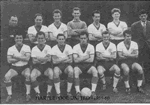 I've updated the Hartlepool United crest history and revised their 2008-09 graphic, which now includes the correct centenary badge. The photograph shows the 1959-60 side wearing shirts which for the first time included a crest, albeit a very simple affair.
I've updated the Hartlepool United crest history and revised their 2008-09 graphic, which now includes the correct centenary badge. The photograph shows the 1959-60 side wearing shirts which for the first time included a crest, albeit a very simple affair.
As a footnote to the recent entries for Bolton Wanderers, Martin Nisbet has provided evidence that shows the original club crest was replaced with a more modern design around 1944-45 and was worn in the 1945 War Cup Final. With the exception of the 1950-51 season this was worn until 1953 when the colours were altered to make it more visible against the Trotters' white shirts.
15 August
 A recent submission from Peter Stevenson prompted me to revisit the excellent Grecian Archive where several new photographs from the late Fifties have appeared since my last visit. These include the team sporting a brand new Continental strip in 1955-56 (left) and provide evidence that the team made several changes to their strips midway through the 1956-57,
A recent submission from Peter Stevenson prompted me to revisit the excellent Grecian Archive where several new photographs from the late Fifties have appeared since my last visit. These include the team sporting a brand new Continental strip in 1955-56 (left) and provide evidence that the team made several changes to their strips midway through the 1956-57, 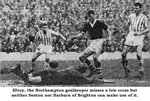 1957-58 and 1958-59 seasons.
1957-58 and 1958-59 seasons.
(Photo credit: The Grecian Archive)
Peter also discovered that Brighton & Hove Albion introduced their candy-striped shirts towards the end of the 1957-58 season (right). Peter's other contributions include Port Vale (1962-63), Aston Villa (1965-66 change) and Peterborough United (1972-73 corrected).
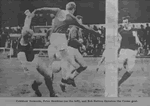 In 1967 Northampton Town dropped the claret shirts with white sleeves that they had worn during their one season in the First Division in favour of a white strip with two claret bands across the chest, keeping this until the end of the 1970-71 season. On 4 April 1969, however, in their final game at home to Crewe Alexandra, the Cobblers' team inexplicably turned out in their old claret and white jerseys.
In 1967 Northampton Town dropped the claret shirts with white sleeves that they had worn during their one season in the First Division in favour of a white strip with two claret bands across the chest, keeping this until the end of the 1970-71 season. On 4 April 1969, however, in their final game at home to Crewe Alexandra, the Cobblers' team inexplicably turned out in their old claret and white jerseys.
Many years ago when beer cost 15p a pint and Ziggy Stardust was a thing I spent a weekend trawling through the complete collection of Football League Handbooks in the archive of the Football League HQ, then in Lytham St Annes. Among the many surprises I 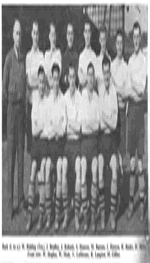 found was an entry for Bolton Wanderers in a post war handbook giving their colours as white shirts, black knickers and red/black socks. Unfortunately I got rid of my notes some years later so when I started work on HFK I could not remember when this odd strip was introduced. I was therefore delighted to hear from Martin Nisbet the other day who, after combing through his collection of Bolton programmes was able to pinpoint when the kit was introduced and when it was retired. The cherry on top of the icing on this particular cake is this photo I found of the 1950-51 team wearing the outfit in question.
found was an entry for Bolton Wanderers in a post war handbook giving their colours as white shirts, black knickers and red/black socks. Unfortunately I got rid of my notes some years later so when I started work on HFK I could not remember when this odd strip was introduced. I was therefore delighted to hear from Martin Nisbet the other day who, after combing through his collection of Bolton programmes was able to pinpoint when the kit was introduced and when it was retired. The cherry on top of the icing on this particular cake is this photo I found of the 1950-51 team wearing the outfit in question.
(Photo credit: The Club Shop)
8 August
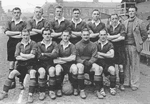 HFK Frequent Flyers will know that until around 1970, when colours clashed in the FA Cup both teams had to change and neither was allowed to wear their first choice strip, which, the FA thought, would give them an unfair advantage. When change strips also clashed a coin was tossed to determine who would have the first
HFK Frequent Flyers will know that until around 1970, when colours clashed in the FA Cup both teams had to change and neither was allowed to wear their first choice strip, which, the FA thought, would give them an unfair advantage. When change strips also clashed a coin was tossed to determine who would have the first 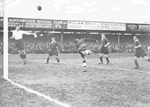 choice of alternate colours. When York City were drawn at home against Middlesbrough, then in the First Division, Boro won the toss and opted to play in their white/black change strip. York borrowed a set of tangerine tops from somewhere which they teamed with black knickers. In a howling gale, the Minster Men triumphed 1-0 in their unfamiliar outfits. They went on to meet Huddersfield Town in the quarter-finals and were narrowly beaten 2-1 in a replay at Leeds Road.
choice of alternate colours. When York City were drawn at home against Middlesbrough, then in the First Division, Boro won the toss and opted to play in their white/black change strip. York borrowed a set of tangerine tops from somewhere which they teamed with black knickers. In a howling gale, the Minster Men triumphed 1-0 in their unfamiliar outfits. They went on to meet Huddersfield Town in the quarter-finals and were narrowly beaten 2-1 in a replay at Leeds Road.
(Photo: City Kits.com)
3 August
I appreciate very much all the warm and supportive emails I've received following the announcement I made a couple of days ago. From the day we launched HFK in June 2006, the active participation of visitors has been at the heart of the project and it is extremely gratifying to hear how this approach to creating new content has delivered so much pleasure and prompted more than a few visitors to dive headlong into new research.
 During lock down I started to revise the Brief History of Football Kits article. I've been working on this over the last two years on and off and this seems like a good moment to launch the results as a work in progress. The original article has been expanded to eight chapters (with three more planned), many new illustrations and research. Please step this way...
During lock down I started to revise the Brief History of Football Kits article. I've been working on this over the last two years on and off and this seems like a good moment to launch the results as a work in progress. The original article has been expanded to eight chapters (with three more planned), many new illustrations and research. Please step this way...
(Photo: Reproduced under licence from Alamy)
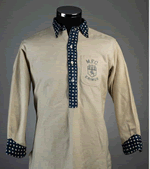 Back in March this extremely rare Middlesbrough shirt was sold for almost £20,000 at auction. Dating from 1886-1890 (you can figure out where the auctioneers got that information from) it is not only one of the oldest shirts to have survived, it is also a unique design with polka dots at the collar and cuff. The photograph also reveal details of the crest that were previously unclear. The BBC Website has more information on the shirt and the auction.
Back in March this extremely rare Middlesbrough shirt was sold for almost £20,000 at auction. Dating from 1886-1890 (you can figure out where the auctioneers got that information from) it is not only one of the oldest shirts to have survived, it is also a unique design with polka dots at the collar and cuff. The photograph also reveal details of the crest that were previously unclear. The BBC Website has more information on the shirt and the auction.
 The oldest known photograph of Tottenham Hotspur is from October 1885 (right). This was taken before the club's first ever competitive match, a London Association Cup match against St Albans. The indefatigable Tony Sealey has found out that it features three players, Burt, Moss and Mason, who joined Spurs after their own club, Star FC, (who also played on Tottenham Marshes) was wound up. Mason is in a Spurs shirt and was the only one of the trio who would play in the game, scoring twice in a surprise 5-2 win. Burt and Moss are wearing the hooped jerseys of their former club, presumably because Spurs did not have enough Cambridge blue and white tops to go round.
The oldest known photograph of Tottenham Hotspur is from October 1885 (right). This was taken before the club's first ever competitive match, a London Association Cup match against St Albans. The indefatigable Tony Sealey has found out that it features three players, Burt, Moss and Mason, who joined Spurs after their own club, Star FC, (who also played on Tottenham Marshes) was wound up. Mason is in a Spurs shirt and was the only one of the trio who would play in the game, scoring twice in a surprise 5-2 win. Burt and Moss are wearing the hooped jerseys of their former club, presumably because Spurs did not have enough Cambridge blue and white tops to go round.
(Photo credits: Graham Budd Auctions, Tottenham Hotspur FC)
18/19 May
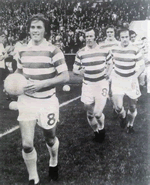 After winning the Scottish First Division title for the eighth time on the trot, Celtic turned out for their first home league game of the season against Clyde on 8 September 1973 with the entire team wearing number eight on their shorts. (Thanks to Tony Sealey for this.)
After winning the Scottish First Division title for the eighth time on the trot, Celtic turned out for their first home league game of the season against Clyde on 8 September 1973 with the entire team wearing number eight on their shorts. (Thanks to Tony Sealey for this.)
Scottish club updates for 1990-91 from Ian McConnel: Heart of Midlothian (detailing corrected), Dunfermline Athletic (stripes and collar trim redrawn), Rangers (detailing on change kit corrected), Dundee United (identical to previous season but with collar reversed), Motherwell (detailing added to socks), Airdrieonians (missing kit added), Arbroath (missing kit added), Cowdenbeath (missing kit added), East Stirlingshire (shirt sponsor added), Kilmarnock (detailing amended).
Alloa Athletic (1984-85 added), Hamilton Academicals (1964-65 added), Airdrieonians (1989-90 detailing corrected), Rangers (1958-59 floodlights kit added).
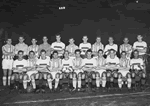 Ian included this intriguing photograph with his latest update. Taken on 11 March 1959 it shows the Caledonian team lining up with a Rangers/Celtic Select XI before a friendly to mark the inauguration of the brand new floodlights at Telford Street. The Old Firm side are wearing Rangers' floodlights kit complete with irridescent blue shorts. Caley, who normally wore plain blue shirts have opted for striped shirts with white shorts and socks. Given that floodlights in this period were not very powerful, these kit choices did ensure that the spectators would be able to see the players on a dark Inverness night.
Ian included this intriguing photograph with his latest update. Taken on 11 March 1959 it shows the Caledonian team lining up with a Rangers/Celtic Select XI before a friendly to mark the inauguration of the brand new floodlights at Telford Street. The Old Firm side are wearing Rangers' floodlights kit complete with irridescent blue shorts. Caley, who normally wore plain blue shirts have opted for striped shirts with white shorts and socks. Given that floodlights in this period were not very powerful, these kit choices did ensure that the spectators would be able to see the players on a dark Inverness night.
17 May
Once again I must apologise for the extended hiatus over the last six weeks. This was due to another bout of illness here at HFK Towers and an extended three-week trip to visit family in Poland. I have also been working behind the scenes to fix a number of issues with our Affiliate Links.
Anyway - back to work...
 Michael Comben of the Pompey History Society has been in touch wth evidence that Portmouth wore their famous moon and star crest from 1912, when they first adopted blue shirts and right through the 20s and 30s. As this photograph of the 1913-14 team illustrates, the badge could be hard to see due to fading in the
Michael Comben of the Pompey History Society has been in touch wth evidence that Portmouth wore their famous moon and star crest from 1912, when they first adopted blue shirts and right through the 20s and 30s. As this photograph of the 1913-14 team illustrates, the badge could be hard to see due to fading in the 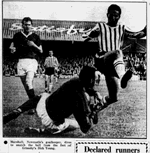 laundry, giving the impression that it was absent. As always, I'm happy to set the record straight.
laundry, giving the impression that it was absent. As always, I'm happy to set the record straight.
I enjoyed this little snippet, found by Tony Sealey in the British Newspaper Archive. In September 1963 Newcastle United, packing their regular black and white first choice kit, travelled to Blundell Park for their match with Grimsby Town. Evidently their kit man didn't bother to check his copy of the Football League Handbook because he failed to realise that Grimsby had switched from white shirts and red shorts to black and white stripes for the new season. After what I imagine was a moment of acute embarrassment, it was decided tht the Toon would play in Grismby's red and white change strip. It just goes to show that in football as in life, you should aways RTFM.*
(Photo credit: Grimsby Evening Telegraph 14 September 1963.)
*Read The Fine Manual.
21 March
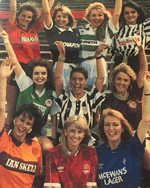 More Scottish club updates: Hibernian (1989-91, 1991-92 trim amended), Motherwell (1989-90 shorts trim adjusted), Dunfermline Athletic (1988-89, 1989-90 collar trim corrected), Caledonian (1989-90 shorts & socks corrected), Airdrieonians (1989-92 socks corrected), St Mirren (1989-91 detailing corrected), Dundee United (1989-91 shadow stripes added), St Johnstone maker's logos corrected, Arbroath (1979-1980 crest added).
More Scottish club updates: Hibernian (1989-91, 1991-92 trim amended), Motherwell (1989-90 shorts trim adjusted), Dunfermline Athletic (1988-89, 1989-90 collar trim corrected), Caledonian (1989-90 shorts & socks corrected), Airdrieonians (1989-92 socks corrected), St Mirren (1989-91 detailing corrected), Dundee United (1989-91 shadow stripes added), St Johnstone maker's logos corrected, Arbroath (1979-1980 crest added).
Southend United (1955-56 added), Stockport County (1965-66, 1966-67 detailing added).
 In November, Hummel's UK licensee, Elite Sports Group, went into administration, resulting in the supply of kit to clubs drying up and several club shops, which were operated by the company, being closed. Although most English clubs affected have since signed up with Hummel's new licensee, SportsPro, Bristol City decided to link up with the Irish sportswear supplier, O'Neills. The team turned out for the first time in their new kit last month.
In November, Hummel's UK licensee, Elite Sports Group, went into administration, resulting in the supply of kit to clubs drying up and several club shops, which were operated by the company, being closed. Although most English clubs affected have since signed up with Hummel's new licensee, SportsPro, Bristol City decided to link up with the Irish sportswear supplier, O'Neills. The team turned out for the first time in their new kit last month.
14 March
It's been a month since my last update and for this I apologise. A couple of days after the update I came down with a severe chest infection which I am only now managing to shake off. Now I can finally have a crack at the backlog of material in my inbox starting with more Scottish club updates from Ian McConnel.
Heart of Midlothian (1988-89, 1989-90 modified), Hamilton Academical (1988-89, 1989-1990 shorts detailing updated), Meadowbank Thistle (198-90 detailing updated), Hibernian (1988-89 detailing updated), Motherwell (1987-89 shorts detailing updated), St Mirren (1987-89 shorts detailing updated), Ayr United (1988-89 logos added to socks), Forfar Athletic (1988-89 shorts corrected), Stenhousemuir (1988-89 socks corrected), Clyde (1988-89 crests corrected), Clydebank (1986-87, 1987-89 shadow stripes adjusted), Rangers (1988-90 change kit applications adjusted).
13 February
After a mid-winter break to get a bit of Egyptian sun and recharge the batteries, I'm resuming with some more updates, starting with Portsmouth.
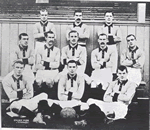 Michael Comben, a member of the Pompey History Society, is currently writing a book about the origins of the club and has been in touch to tell me that their original shirts were salmon pink rather than the standard pink I previously showed. This is backed up by numerous contemporary newspaper references as well as the 1899 FA Handbook. As always I am happy to set the record straight.
Michael Comben, a member of the Pompey History Society, is currently writing a book about the origins of the club and has been in touch to tell me that their original shirts were salmon pink rather than the standard pink I previously showed. This is backed up by numerous contemporary newspaper references as well as the 1899 FA Handbook. As always I am happy to set the record straight.
Although the club was formed in April 1898 it was not until the Spring of 1899 that they acquired a ground and signed their first players. The photograph is of the 1899-1900 team.
I also now have confirmation from Tony Sealey of when the eight-pointed star was adopted on Pompey's crest and have established that the hooped socks worn a few times at the end of the 1957-58 season were in fact blue and white.
 It had escaped my notice until now that back in November, Derby County finally found a shirt sponsor, the children's charity, NSPCC. The new tops were debuted against Morecambe and attracted some puzzled comments because the NSPCC logo appeared in several different colours ranging from mid-green (the correct shade) through turquoise to pale blue. The most likely explanation is that the printer charged with adding the logos ran out of yellow ink (to be mixed with blue to make green) but carried on regardless.
It had escaped my notice until now that back in November, Derby County finally found a shirt sponsor, the children's charity, NSPCC. The new tops were debuted against Morecambe and attracted some puzzled comments because the NSPCC logo appeared in several different colours ranging from mid-green (the correct shade) through turquoise to pale blue. The most likely explanation is that the printer charged with adding the logos ran out of yellow ink (to be mixed with blue to make green) but carried on regardless.
(Photo credit: www.footyheadlines.com)
Nottingham Forest now wear the logo of the United Nations Refugee Agency (UNHCR) on their shirts and have made a "substantial donation" to the organisation.
26 January
During 1948-49 Wolverhampton Wanderers occasionally wore short sleeved old gold shirts. The monogram and shorts trim on the one-off kit worn by Chelsea in the 1966 FA Cup semi-final were red rather than white as previously shown.
25 January
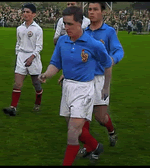 World Cup 1950: Uruguay added a crest to their shirts for their 1950 match against Spain.
World Cup 1950: Uruguay added a crest to their shirts for their 1950 match against Spain.
World Cup 1958: It appears that Yugoslavia wore their usual red socks against France.
Due to the arcane rule (now long abandoned) that required both teams to change when colours clashed in the FA Cup, Chelsea turned out in unfamiliar colours on three occasions in the 1930-31 competition: black knickers with their usual blue shirts at home against Blackburn Rovers, red and white stripes against Birmingham (who borrowed Huddersfield's shirts for this game) and blue and white stripes in the replay.
18 January - A Miscellany
Aston Villa (1985-86 crest added to shorts), Hamilton Academical (1976-77, 1977-79 modified), Middlesbrough (1972-73 matches in which the variant 4 kit was worn expanded), Wycombe Wanderers (1979-80 cold weather kit added), Leicester City (1938-46, 1946-47, 1947-48, August 1948, 1948-49, 1949-50, 1951-52 added).
Although Nottingham Forest adopted plain red tops in 1971-72, between October and November they played at least three matches wearing their previous tops with red and white trim.
10 January - Scottish Club Update
 Montrose (1986-87 added), Hibernian (1986-87 sponsorship amended, 1987-88 detailing amended), Heart of Midlothian (1986-87, 1987-88 detailing added or corrected), Aberdeen (1986-87 1987-90 detailing enhanced), Clydebank (1986-87, 1987-89 shadow stripes adjusted), Kilmarnock (1986-87, 1987-88, 1988-89 detailing amended), Hamilton Academical (1986-87 alternate shirts added), Dundee (1987-89 crest added to shorts), Dunfermline Athletic (1986-88 crest added to shorts), Caledonian (1987-89 shorts trim adjusted), Rangers (1987-90 shoulder seam added), Rangers Change (1987-90 added), St Mirren (1987-88 shorts corrected - see photo),
Montrose (1986-87 added), Hibernian (1986-87 sponsorship amended, 1987-88 detailing amended), Heart of Midlothian (1986-87, 1987-88 detailing added or corrected), Aberdeen (1986-87 1987-90 detailing enhanced), Clydebank (1986-87, 1987-89 shadow stripes adjusted), Kilmarnock (1986-87, 1987-88, 1988-89 detailing amended), Hamilton Academical (1986-87 alternate shirts added), Dundee (1987-89 crest added to shorts), Dunfermline Athletic (1986-88 crest added to shorts), Caledonian (1987-89 shorts trim adjusted), Rangers (1987-90 shoulder seam added), Rangers Change (1987-90 added), St Mirren (1987-88 shorts corrected - see photo),
My thanks go to Ian McConnel for this material.
5 January
Eminent Victorians Scottish Section: Tarff Rovers, Thistle Athletic, Thornhill, Tollcross, United Abstainers Athletic, Vale of Leithen, Vale of Leven Hibernian, Wellington Park, West End (corrected), Whifflet Shamrock, Wick Rovers.
Eminent Victorians Welsh Section: Carnarvon Wanderers, Llanerchrugog.
This completes the Eminent Victorians project although further additions will be made as information comes to light.
4 January
Eminent Victorians Scottish Section: Newmains, Oban, Oban Rangers, Paisley Celtic, Partick Carrick, Polton Vale, Saltcoats Victoria, Selkirk, Shawlands Athletic, Strathmore (corrected), Swifts.
3 January
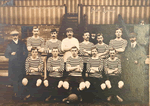 And we're back in the room - Happy New Year!
And we're back in the room - Happy New Year!
This intriguing photograph of a very early Preston North End team was sent to me by Linda Martin who wants to know more about the players - if you can help please let me know.
Linda also asked me to estimate when the picture was taken. We know from The History of PNEFC (David Hunt) that Preston wore one-inch navy and white hoops between 1882 and 1884 when they adopted red and white halves. Photographs in Hunt's book reveal the hooped jerseys were worn with white knickerbockers. This leaves 1880-82 not acounted for and I am confident the picture is from this period. Furthermore, the players' kit is absolutely pristine and shows no sign of wear and tear, indicating it is brand new. The club formally adopted association football in May 1880 and I believe the photograph was probably taken shortly afterwards to mark this auspicious occasion.
It also struck me that, aside from the goalkeeper, the players are wearing identical kit. We must remember that at the time the FA rules required that players provide their own kit. Most team photographs of the period show players wearing all sorts of tops and a mixture of white and dark knickers.The most prominent Lancashire clubs, Preston, Blackburn Rovers and Darwen all offered inducements to Scottish players to join them with offers of jobs, housing and illicit payments in breach of the FA rules. It would not surprise me if the Preston committee had gone further and purchased the playing kit for their team.
 Contrast the smart appearance of Preston North End with that of the Queen's Park team from 1888 on the right. The Scottish club, of course, held strictly to amateur principles even after professionalism was recognised in Scotland in 1893. They had adopted their famous hooped jerseys in 1873 and the club rule book specified that these should have 32 one-inch stripes against a white background and be worn with white knickers. It is apparent, however, that the playing members wore jerseys and shirts with both horizontal and vertical stripes as well as a variety of knickers.
Contrast the smart appearance of Preston North End with that of the Queen's Park team from 1888 on the right. The Scottish club, of course, held strictly to amateur principles even after professionalism was recognised in Scotland in 1893. They had adopted their famous hooped jerseys in 1873 and the club rule book specified that these should have 32 one-inch stripes against a white background and be worn with white knickers. It is apparent, however, that the playing members wore jerseys and shirts with both horizontal and vertical stripes as well as a variety of knickers.
(Photo credits: Linda Martin, Beyond the Last Man)
Eminent Victorians Scottish Section: Lochee, Maryhill, Maybole, Maybole Ladywell, Methlan Park, Moffat, Motherwell Shamrock, Northern (corrected).